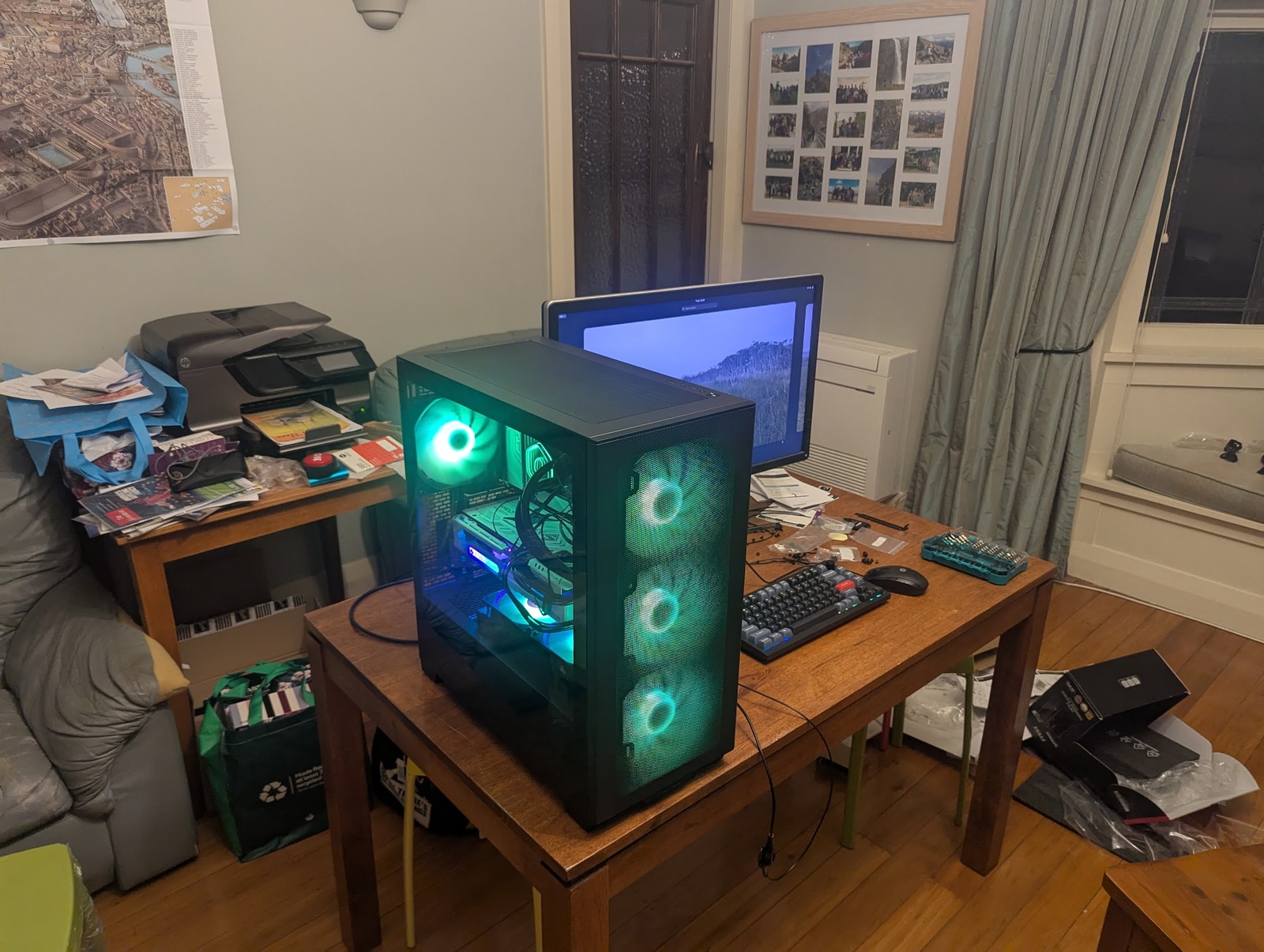Wednesday 11 June 2025
Building A PC
My personal computing device was a laptop I bought in 2016 when I left Mozilla. It still works well, but after 9 years I thought it was reasonable to buy a new machine. I don’t game much but when I do I’d like to be able to play modern games. I like to do some software development on my personal machine, and when I was working on LLDB it was very painful on the old laptop.
To cut a long-ish story short, I specced out a reasonably priced but capable PC build on PBTech’s PC Builder site, bought the parts and put them together myself last weekend. There were some scary moments but I got it all working in one day. More details below! It’s great; the game I’m playing now (Solasta) and the game I will probably play next (Baldur’s Gate 3) work perfectly in Linux with Steam — 60fps at maximum quality settings on my 4K monitor. (The monitor, a Dell P2715Q, is also 9 years old but I see no need to update that yet. I love it.)
What I didn’t expect is how generally snappy the system feels, and how much I enjoy using it because of that. It’s partly the Keychron keyboard — I’ve used a lot of keyboards over the years and never felt strongly about any of them, but this one is great. I feel like I’m typing faster and more accurately than with other keyboards. Whether or not that’s true, it makes the whole user experience feel better, especially when I’m working.
So here’s what I got. My general approach was to buy parts at the higher performance end of the “value for money” space.
-
CPU: Intel Core Ultra 7 265KF (Arrow Lake, 8 performance cores, 12 efficiency cores) I know there have been some performance issues with Arrow Lake, but I want to add proper support for Intel hybrid cores to rr, so I need this. 20 cores is certainly a nice upgrade from my 4-core laptop.
-
GPU: ASRock AMD Radeon RX 9070 XT (16GB VRAM) I like an underdog.
-
RAM: G.Skill “Ripjaws” 64GB DDR5 The branding makes me feel eight years old.
-
Samsung 990 Pro 2TB SSD
-
ASRock Z890 Pro RS WiFi ATX Motherboard
-
MSI MPG 850W Power Supply
-
Cooler Master MasterLiquid 240 Core II ARGB
-
Phanteks XT PRO Ultra Black ATX Case
-
Keychron V1-D3 V1 ANSI 75% Mechanical Wired Keyboard
I opted to build it myself, mainly for fun, but partly because I wanted to learn a bit about how modern PCs are put together. That also meant I didn’t have to buy a copy of Windows, which I would just have deleted immediately. That saved me 200 NZD, which isn’t much, but it gave me a good feeling. The whole system cost a bit under 4K NZD.
I spent about seven hours putting it together. That’s a lot longer than necessary, because I didn’t know what I was doing, and spent quite a lot of time reading the instructions and trying to understand them. A few times I had to take things apart and put them back together properly, especially cable routing.
There was moment of fear when I was finally ready to turn the system on. I braced myself for smoke, or nothing at all. And the latter is what I got! So I panicked for a while. Eventually I discovered that there is no built-in speaker anymore to play POST beeps, but there are coloured LEDs on the motherboard with some diagnostic information. They indicated my GPU was not working properly. I pulled the GPU and reseated it, and the motherboard was happy.
But there was still nothing visible on the screen! I was stumped for a while. There was no OS installed yet, so I expected to see some BIOS output complaining about that. I did notice the screen was on and apparently receiving input from the GPU. I wondered whether the BIOS output was somehow not showing up, and whether trying to boot Linux from USB would do anything — so I tried that. It worked! Linux kernel boot messages appeared. I’ve never been so happy to see them. I still don’t know why the BIOS didn’t show anything.
Anyway, Linux (Fedora 42) booted from USB and worked. I configured Wifi, installed Linux on the SSD and rebooted into it, installed Steam, and ran my games, and everything just worked perfectly, including the excellent game performance mentioned above. The only tweak I had to make was to tell Steam to ignore its compatibility constraints and allow my games to run on Linux. It’s been a long road, but on this evidence Linux is really good now.
One more thing — at some point people figured out how to make PC fans really quiet. This system has nine fans altogether and only when I’m gaming do I hear anything at all.
